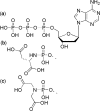Iminodiacetic-phosphoramidates as metabolic prototypes for diversifying nucleic acid polymerization in vivo
- PMID: 20097909
- PMCID: PMC2860114
- DOI: 10.1093/nar/gkp1246
Iminodiacetic-phosphoramidates as metabolic prototypes for diversifying nucleic acid polymerization in vivo
Abstract
Previous studies in our laboratory proved that certain functional groups are able to mimic the pyrophosphate moiety and act as leaving groups in the enzymatic polymerization of deoxyribonucleic acids by HIV-1 reverse transcriptase. When the potential leaving group possesses two carboxylic acid moieties linked to the nucleoside via a phosphoramidate bond, it is efficiently recognized by this error-prone enzyme, resulting in nucleotide incorporation into DNA. Here, we present a new efficient alternative leaving group, iminodiacetic acid, which displays enhanced kinetics and an enhanced elongation capacity compared to previous results obtained with amino acid deoxyadenosine phosphoramidates. Iminodiacetic acid phosphoramidate of deoxyadenosine monophosphate (IDA-dAMP) is processed by HIV-1 RT as a substrate for single nucleotide incorporation and displays a typical Michaelis-Menten kinetic profile. This novel substrate also proved to be successful in primer strand elongation of a seven-base template overhang. Modelling of this new substrate in the active site of the enzyme revealed that the interactions formed between the triphosphate moiety, magnesium ions and enzyme's residues could be different from those of the natural triphosphate substrate and is likely to involve additional amino acid residues. Preliminary testing for a potential metabolic accessibility lets us to envision its possible use in an orthogonal system for nucleic acid synthesis that would not influence or be influenced by genetic information from the outside.
Figures







Similar articles
-
Iminodipropionic acid as the leaving group for DNA polymerization by HIV-1 reverse transcriptase.Chembiochem. 2011 Aug 16;12(12):1868-80. doi: 10.1002/cbic.201100160. Epub 2011 Jun 28. Chembiochem. 2011. PMID: 21714056
-
Polymerase-catalyzed synthesis of DNA from phosphoramidate conjugates of deoxynucleotides and amino acids.Nucleic Acids Res. 2007;35(15):5060-72. doi: 10.1093/nar/gkm498. Epub 2007 Jul 25. Nucleic Acids Res. 2007. PMID: 17652326 Free PMC article.
-
Phosphodiester substrates for incorporation of nucleotides in DNA using HIV-1 reverse transcriptase.Chembiochem. 2009 Sep 4;10(13):2246-52. doi: 10.1002/cbic.200900270. Chembiochem. 2009. PMID: 19637144
-
3-Phosphono-L-alanine as pyrophosphate mimic for DNA synthesis using HIV-1 reverse transcriptase.Org Biomol Chem. 2011 Jan 7;9(1):111-9. doi: 10.1039/c0ob00554a. Epub 2010 Nov 22. Org Biomol Chem. 2011. PMID: 21103490
-
Protein-nucleic acid interactions and DNA conformation in a complex of human immunodeficiency virus type 1 reverse transcriptase with a double-stranded DNA template-primer.Biopolymers. 1997;44(2):125-38. doi: 10.1002/(SICI)1097-0282(1997)44:2<125::AID-BIP2>3.0.CO;2-X. Biopolymers. 1997. PMID: 9354757 Review.
Cited by
-
Hypothesis of design of biological cell robot as human immunodeficiency virus vaccine.World J Virol. 2020 Sep 25;9(3):19-26. doi: 10.5501/wjv.v9.i3.19. World J Virol. 2020. PMID: 33024716 Free PMC article.
-
Conjugation of phosphonoacetic acid to nucleobase promotes a mechanism-based inhibition.J Enzyme Inhib Med Chem. 2018 Dec;33(1):384-389. doi: 10.1080/14756366.2017.1417275. J Enzyme Inhib Med Chem. 2018. PMID: 29372656 Free PMC article.
-
Synthesis of nucleoside phosphate and phosphonate prodrugs.Chem Rev. 2014 Sep 24;114(18):9154-218. doi: 10.1021/cr5002035. Epub 2014 Aug 21. Chem Rev. 2014. PMID: 25144792 Free PMC article. Review. No abstract available.
References
-
- Herdewijn P, Marliere P. Toward safe genetically modified organisms through the chemical diversification of nucleic acids. Chem. Biodivers. 2009;6:791–808. - PubMed
-
- Ghadessy FJ, Ramsay N, Boudsocq F, Loakes D, Brown A, Iwai S, Vaisman A, Woodgate R, Holliger P. Generic expansion of the substrate spectrum of a DNA polymerase by directed evolution. Nat. Biotechnol. 2004;22:755–759. - PubMed
-
- Pochet S, Kaminski A, Van Aerschot A, Herdewijn P, Marlière P. Replication of hexitol oligonucleotides as a prelude to the propagation of a third type of nucleic acid in vivo. C.R. Biol. 2003;326:1175–1184. - PubMed
-
- Renders M, Lievrouw R, Krecmerova M, Holy A, Herdewijn P. Enzymatic polymerization of phosphonate nucleosides. Chembiochem. 2008;9:2883–2888. - PubMed
-
- Adelfinskaya O, Herdewijn P. Amino acid phosphoramidate nucleotides as alternative substrates for HIV-1 reverse transcriptase. Angew. Chem. Int. Ed. 2007;46:4356–4358. - PubMed
Publication types
MeSH terms
Substances
LinkOut - more resources
Full Text Sources
Other Literature Sources

